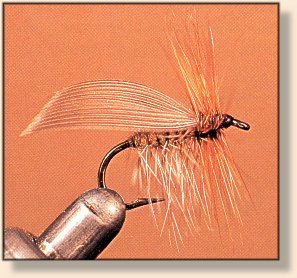
 Henryville Special By Skip Morris
|
|
|
1. Start the thread, tie in a grizzly hackle, (one size smaller
than usual) at the bend, add dubbing or tie in floss, and wrap
a body up two-thirds of the shank. (If you used floss, bind
its end and trim it.)
2. Palmer the hackle up the body in about six turns, secure
the hackle's tip with thread turns, and trim the tip. Trim
the hackle fibers from the top half of the body.
3. Using the pinch, tie in a bunch of fibers from a
wood-duck or mallard-dyed-to-wood-duck-color feather atop
the body. Trim the butts of the fibers and bind them with
thread.
4. Tie in a matched set of quill wings, long edges down,
cupped around the wood duck. You can tie both quill sections
in at the same time using the wing pinch, but I prefer to
tie the quills in down the sides of the body a bit, one
at a time.
5. Snip the butts of the quills and bind them with thread.
(Note the length of the wings; they can be slightly longer
or shorter, but what you see is about right.) Tie in two
brown hackles (or only one if you prefer).
6. Wind the first hackle, secure its tip under thread
turns, and then wind the second hackle through the first
(unless, of course, you are using only one hackle). Secure
the second hackle's tip with thread, and then trim both
tips. Create a thread head and complete the fly as
usual." ~ Skip Morris
Credits: From the Art of Tying the Dry Fly
by Skip Morris, published by Frank Amato Publications, Inc.
We greatly appreciate use permission.
For more great flies, check out:
Beginning Fly Tying,
Intermediate Fly Tying and Advanced
Fly Tying.
|
[ HOME ]
[ Search ] [ Contact FAOL ] [ Media Kit ]





